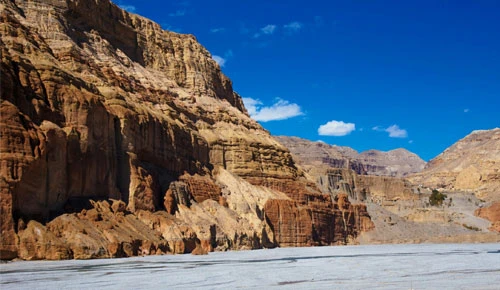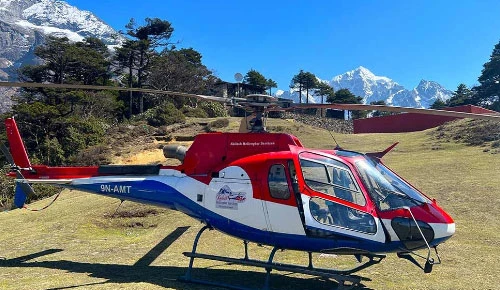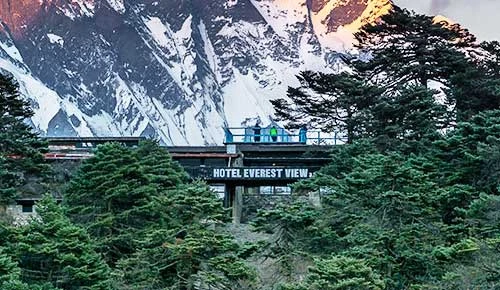Rara National Park
Rara National Park is situated in the Karnali region of northwest Nepal. Rara Lake, the main attraction of the park and the biggest lake in the nation, is located within its 106-square-kilometer extent, which was established in 1976.
The park is named after this magnificent Rara Lake. The park sits between lush green forests and snow-covered mountains, offering a stunning view of the entire area.
Many animal species, including musk deer, red pandas, and Himalayan black bears, and several bird species, including the critically endangered cheer pheasant, can be found there.
Rara National Park's unspoiled surroundings make it the perfect place for hikers, wildlife enthusiasts, and birdwatchers looking for peace amid the Himalayas' breathtaking scenery.

One of the most popular activities in Rara National Park is trekking, with several trails extending from various locations around the park to the lake. The most well-liked hiking path starts in Jumla and travels to the lake over three to four days.
Travelers can take in breathtaking vistas of alpine meadows, thick woods, and peaks covered in snow throughout the route. Within the park, camping is permitted, enabling guests to completely immerse themselves in the surrounding environment.
Essential Information of Rara National Park
Feature | Description |
Location | Mugu & Jumla Districts, Western Nepal |
Area | 106 sq. km (41 sq. miles) |
Buffer Zone | 198 sq. km (76 sq. miles) |
UNESCO World Heritage Site | No |
Established | 1976 |
Number of Plant Species | Over 1,200 |
Number of Mammal Species | Over 51 |
Number of Bird Species | Over 270 |
Key Attraction | Rara Lake (largest freshwater lake in Nepal) |
Popular Activities | Hiking, boating, birdwatching, and cultural experiences |
Table of Contents
History of Rara National Park
The main reason behind Rara's establishment in 1976 was to preserve the distinctive environment that surrounds Nepal's largest lake, Rara Lake.
The park's establishment was an attempt to preserve the region's unique biodiversity, which includes a wide variety of plants and animals.
The region surrounding Rara Lake was well known for its ecological value and natural beauty before it was designated as a national park. But growing human activities like overgrazing, poaching, and deforestation were endangering the ecosystem's sensitive balance.
The Nepalese government classified the region as a protected area under the National Parks and Wildlife Conservation Act to address these risks and guarantee the area's long-term preservation.
Since its founding, Rara National Park has been essential to maintaining the unspoiled ecosystem that envelops Rara Lake and the woodlands that surround it.
The Department of National Parks and Animal Conservation is in charge of managing the park and is in charge of several conservation projects, including habitat restoration, animal monitoring, and community participation programs.
With time, Rara National Park has drawn tourists from all over the world as a prominent eco- and adventure-tourism destination. Trekking, wildlife observation, bird watching, and cultural interactions with the neighboring communities are among the activities available in the park.
Nonetheless, measures have been taken to guarantee that tourism-related activities are sustainable and do not negatively affect the park's delicate environment.
Flora and Fauna of Rara National Park
Renowned for its abundant and varied flora and wildlife, Rara National Park is home to a wide range of habitats, from alpine meadows to temperate woods. An overview of the park's vegetation and animals can be obtained here:
Flora
Rara National Park's diverse temperature and altitude contribute to its remarkable diversity of flora. The park supports more than 1,070 different plant species.
In particular, the park holds more than fifty varieties of therapeutic flora, demonstrating the significance of the natural surroundings for nearby populations.
- Lush coniferous woods, mostly made up of blue pine, chir pine, and fir, predominate at the lower altitudes of Rara National Park. These woodlands add to the park's visual appeal and provide a home for a wide range of species.
- Coniferous woods give way to mixed temperate forests as elevation rises. The forests around the park are filled with many different kinds of trees, like oak, rhododendron, maple, and juniper. When the rhododendrons blossom in brilliant hues in the spring, these woodlands are especially breathtaking.
- During the short summer months, alpine meadows at higher elevations above the treeline cover the terrain in a riot of color. Numerous grasses and wildflowers adapted to the hard alpine climate may be seen growing in these meadows.
Fauna
The fauna that inhabits Rara National Park is very diverse. More than 51 species of animals can be found in the park, including the Himalayan black bear, musk deer, endangered red panda, and rare snow leopard. In addition, there are approximately 270 known species of birds in the park.
- The rare musk deer is found in just a few remaining areas in Nepal, including Rara National Park. Since traditional medicine uses their scent, these isolated and rare creatures are highly valued.
- Another well-known park resident is the red panda, a cute and vulnerable animal that mostly eats bamboo. The environment, like Rara National Park, is essential to the survival of this threatened species.
- The Himalayan black bear is a dangerous predator that feeds on small animals, birds, and insects. It lives in the deep woods of Rara National Park. These bears are essential to preserving the park's natural equilibrium.
- With over 200 kinds of birds identified within its borders, Rara National Park is a birdwatcher's dream. Several species of eagles, vultures, and owls are among the noteworthy ones, along with the Himalayan monal, Kalij pheasant, and the endangered cheer pheasant.
Activities to do in Rara National Park
Trekking: Trekking is one of the most well-liked activities in Rara National Park. There are several hiking paths that go to Rara Lake, varying in difficulty from simple to moderate. Trekking gives you the chance to discover the park's varied topography, which includes verdant woods, alpine meadows, and expansive vistas of the mountains.
Boating: Getting out on a boat is one of the greatest ways to get a close-up look at the splendor of Rara Lake, which is the park's centerpiece. Accessible rowboats and paddleboats allow guests to explore the lake's pristine waters while admiring the surrounding landscape.
Viewing Wildlife: The Himalayan black bear, red panda, musk deer, and many bird species can all be found in Rara National Park. Whether you're lounging by the lake or hiking the trails, there are plenty of opportunities to see wildlife in the park.
Birdwatching: Rara National Park is a birdwatcher's delight, with over 200 kinds of birds documented inside its confines. Bring binoculars and look for vibrant species like the Himalayan monal, Kalij pheasant, and cheer pheasant, among others.
Camping: Visit Rara National Park and spend a night beneath the stars. Within the park, there are designated camping places where you can put up your tent and spend a quiet evening in the company of the natural world. Just make sure you have the required licenses and adhere to the leave-no-trace policy to reduce your environmental effects.
Village Visits: Take advantage of this chance to discover more about the customs and culture of the people who live in the traditional villages around Rara National Park. Engaging in conversation with the friendly inhabitants might yield significant knowledge about the area's past, customs, and traditions.
Villages near Rara National Park
Although there aren't any villages inside Rara National Park itself, because the area is protected, there are several villages along its boundaries that provide an insight into the local way of life. Below is a list of a few of them:
- Murma settlement: Approximately an hour's walk from Rara Lake, this settlement is home to the Mugu people. The region's traditional way of life, with its distinctive architecture and farming methods, is available to tourists.
- Talcha Airport settlement: This settlement is next to Talcha Airport, which is the park's air entrance. It provides travelers with rudimentary facilities and is the starting point for hikes to the park headquarters.
- Gammara hamlet: Gammara village is located on the shores of Rara Lake. Traditional homestay alternatives are available, allowing visitors to engage with the community and get insight into their customs and way of life.
- Dhunai settlement: Dhunai is close to the park's southern boundary. While exploring the surroundings, visitors can savor regional cuisine and participate in cultural activities.
Entry Fees for Rara National Park
The entry fee for Rara National Park is divided into many categories based on nationality:
- Foreign visitors must pay NPR 3,000 (about USD 22) for each person to enter.
- SAARC nationals: NPR 1,500 (about $11) per person.
- Nepali nationals: NPR 100 per person.
- Please note that children under the age of ten get free entry.
Important Guidelines while visiting Rara National Park
- Prior to visiting Rara National Park, make sure you have a valid admission permit.
- Observe park guidelines and restrictions to show your support for conservation initiatives.
- Make sure you only camp in approved places and have the required permissions before spending the night.
- Keep a safe distance from wildlife and avoid interfering with its natural activities.
- Remain on approved hiking routes and think about hiring an authorized guide.
- When boating on Rara Lake, always use a life jacket and abide by the safety regulations.
- Observe the traditions and culture of the neighboring communities.
- Reduce your use of plastic and dispose of garbage in an ethical manner.
- Use approved fire pits for cooking and pay attention to fire safety regulations.
- Carry necessary supplies and familiarize yourself with emergency protocols to ensure you are ready for any eventuality.
- Utilize the leave-no-trace philosophy to reduce your influence on the environment.
- Before taking pictures of or engaging with locals, get their permission.
- Respect the customs of the place by dressing modestly.
Discover the Beauty of Rara National Park
In summary, Rara National Park is a hidden treasure in the Karnali area of Nepal, providing breathtaking scenery, a wide variety of species, and a wealth of cultural experiences.
Visitors are reminded of the value of responsible tourism and conservation efforts while they explore the area's serene woods, spotless lakes, and quaint village efforts that will help protect this natural beauty for future years.
Adventurers are invited to explore the splendor of Rara National Park and experience the enchantment of the Himalayas.








